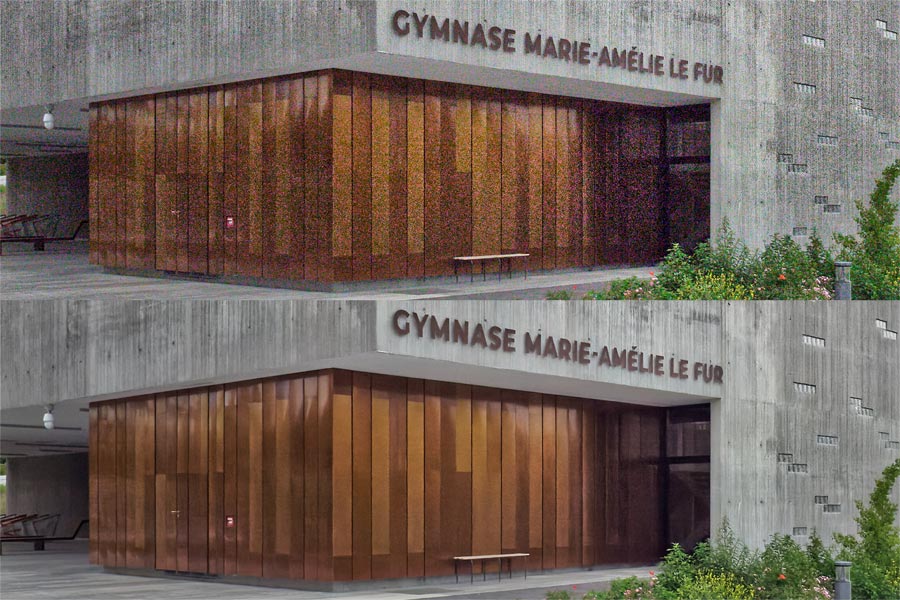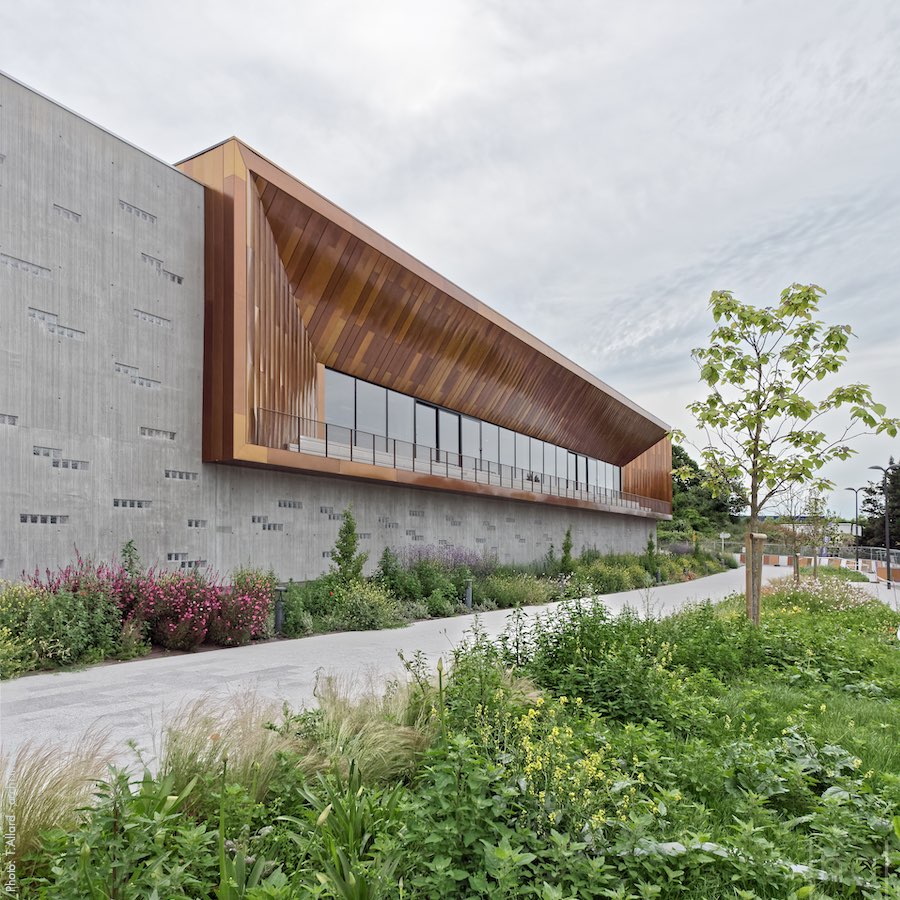
For architectural shots with strong backlighting, we recommend using a tripod and taking several photographs with different exposures: either automatically, using your camera’s HDR function, or by bracketing the images yourself to be able to assemble them in post-processing.
Let’s see how underexposing a single freehand shot can correct backlighting.
An architectural photo retouching tutorial from Lyon-based architectural photographer T.Allard.
I was passing through Bry-sur-Marne, just a stone’s throw from Paris, when I stumbled across this new gymnasium in gray and copper colors, whose architecture immediately appealed to me.

Designed by Bordeaux architects Atelier Ferret Architectures, the Marie-Amélie Le Fur gymnasium blends raw concrete on the façade with a cladding of copper sheeting created by the Balas group.
Shooting against the light?
In a professional context, we program architectural shots according to the exposure of a building, and we generally avoid photographing facades with strong backlighting in the middle of the day…
On a personal trip that day, I didn’t have my professional camera, nor a tripod that would have allowed me to take several identical shots with different exposures.
Nor did I have time to wait for the sun to go around the gymnasium…
The conditions didn’t seem to be conducive to quality architectural shots, especially as the surrounding area was still under construction.
How, then, can you produce and retouch images that are “publishable” without having a completely “burnt” sky?
The underexposure technique

Carrying my little Lumix GX9 hybrid camera with a 4/3 sensor, I’m going to push it to its limits by exposing my shot to the cloudy sky, while the sun is in front of me!
As it’s the middle of the day, the ISO 200 shot is taken at 1/10000, enough to avoid motion blur!
Black is black?

I get an image that might discourage many photographers: a cloudy sky with a white spot (the sun) and a building that appears charred!
I’m going to have to rely on my camera’s sensor, and hope that it’s able to record as much information as possible in the underexposed part of my photograph…
Fortunately for me, APS-C sensors tend to do better than full-frame sensors in underexposed conditions.
Backlight photo retouching

After applying a few corrections such as slight exposure compensation, straightening the verticals and cropping my image, I end up with a first version that’s still extremely dark, looking almost black and white!
First, I’m going to use the “Smart lightning” function in the DxO Photolab image processing application.

The magic happens immediately, and color reappears as the gymnasium and vegetation lighten.
The absence of contrast on the building is due to the backlighting, since no direct light shines on the 2 façades.
This “Smart lightning” correction means retaining as much information as possible in the highlights, while increasing exposure in the darker parts of the image.
Technically, I could carry out this type of retouching in a photo editing application like Photoshop, but much less quickly than with a simple slider like here.
A view of the image at its actual size allows us to “appreciate” the significant noise present throughout the brightened building, which a few years ago would have rendered this image unusable…

But that’s without taking into account the real “miracle” made possible by DxO Photolab’s DeepPrime function, which enabled me to recover the concrete pattern and color gradations in the copper while maintaining acceptable image definition.
Final retouching will be carried out on the facades to restore micro-contrast and recover more detail in the concrete.
I’ll also apply a slight desaturation to all the most underexposed areas of the image, then correct the area still “burnt” by the sun.

I don’t mind the ethereal, slightly graying look, but I still take a detour into Photoshop to bring back a little pep.
Corrected backlighting
Duplicating the image on a higher layer with a 35% soft light setting brings stronger contrast and more vivid colors to the image.

With the cloudy sky acting as a light diffuser, reducing harsh shadows, the result is similar to some early-morning images, just before sunrise.
In the end, from a single image taken with a small hybrid camera, it was possible to treat a marked backlight and obtain a respectable result thanks to “simple” photo retouching!
The Marie-Amélie Le Fur Gymnasium

To be built on the grounds of the Bry-sur-Marne sports park between 2019 and 2021, the gymnasium and climbing wall will be used by schools and associations. It is part of an overall development project linked to the new Bry-Villiers-Champigny station being built for the Grand Paris Express.
Marie-Amélie Le Fur is a French disabled athlete who has won nine medals at 4 successive Paralympic Games. She was elected head of the French Paralympic Committee in 2018.





